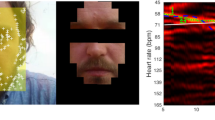Abstract
Since the time of Dick Tracy cartoons, the idea of wearable videoconferencing devices has been a desirable but unachievable goal. Current technology is now on the verge of making this dream a reality. Existing and future low bit-rate video coding standards such as H.263 and MPEG-4 may require specialized hardware for real-time handheld video conferencing [3]. This paper evaluates the performance of software-based videoconferencing on widely available mobile handheld devices using a range of both traditional and original video coding schemes. Our results demonstrate that wearable videoconferencing can no longer be relegated to the realm of science fiction as practical first generation devices are feasible today.
Similar content being viewed by others
References
M. Antonini, M. Barlaud, P. Mathieu, and I. Daubechies, “Image coding using wavelet transform,” IEEE Transactions on Image Processing, Vol. 1, pp. 205–220, 1992.
Apple Computer, “Newton programmer's reference,” 1996.
M. Budagavi, W. R. Heinzelman, J. Webb, and R. Talluri, “Wireless MPEG-4 video communication on DSP chips,” IEEE Signal Processing Magazine, Vol. 17, No. 1, pp. 36–53, 2000.
K. Cinkler, “Very low bit-rate wavelet video coding,” IEEE Journal on Selected Areas in Communications, Vol. 16, pp. 4–11, 1998.
M. Culbert, “Low power hardware for a high performance PDA,” in Proceedings of the IEEE Computer Conference, pp. 144–147, 1994.
J. Faichney, “Mobile, handheld video conferencing,” Honours dissertation, School of Information Technology, Griffith University, Australia, 1998.
M. Flack, Cellular Communications for Data Transmission, Blackwell: Manchester, England: Blackwell, 1990.
B. Furht, S.W. Smoliar, and H. Zhang, Video and Image Processing in Multimedia Systems, Kluwer: Norwell, Massachusetts, ch. 5, 1995.
M.D. Initiative, “GSM world markets,” Technical report, 1998. http://www.gsmdata.com/worlmark.htm.
T. Ishiguro and K. Iinuma, “Television bandwidth compression transmission by motion-compensated interframe coding,” IEEE Communicatons Magazine, Vol. 20, pp. 24–30, 1982.
A. Said and W.A. Pearlman, “A new fast and efficient image codec based on set partitioning in hierarchical trees,” IEEE Transactionson Circuits and Systems for Video Technology, Vol. 6, pp. 243–250, 1996.
H. Samet, “Hierarchical representations of collections of small rectangles,”ACMComputing Surveys, Vol. 20, pp. 297–309, 1998.
J.M. Shapiro, “An embedded wavelet hierarchical image coder,” in Proceeding of the IEEE International Conference on Audio, Speech andS Signal Processing, Vol. 4, pp. 657–660, 1992.
J. Streit and L. Hanzo, “Fixed-rate video codecs for mobile radio systems,” European Transactions in Telecommunications, Vol. 9, No. 6, pp. 551–572, 1997.
R. Welland, G. Seitz, L. Wang, L. Dyer, T. Harrington, and D. Culbert, “The Newton Operating System,” in Proceedings of the IEEE Computer Conference, pp. 148–155, 1994.
Author information
Authors and Affiliations
Rights and permissions
About this article
Cite this article
Faichney, J., Gonzalez, R. Video Coding for Mobile Handheld Conferencing. Multimedia Tools and Applications 13, 165–176 (2001). https://doi.org/10.1023/A:1009689110306
Issue Date:
DOI: https://doi.org/10.1023/A:1009689110306




